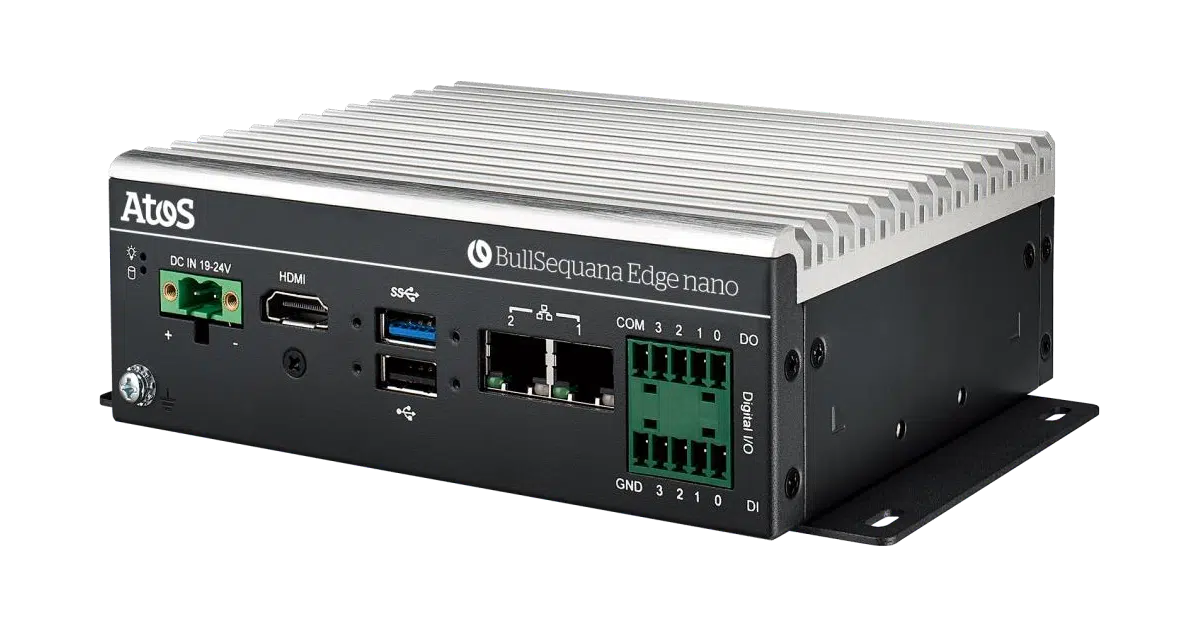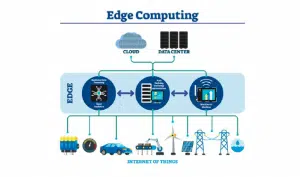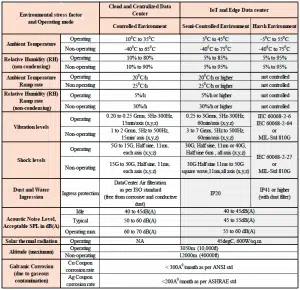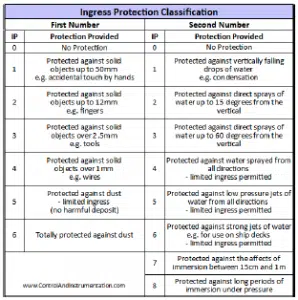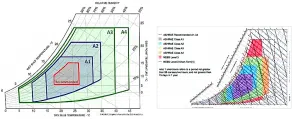Introduction
This article provides an overview of Edge server trends, application, and design challenges for deployment in a harsh environment. The growing demand for compute speed, data bandwidth in modern IoT applications and AI-based time-sensitive critical applications are putting a heavy strain on cloud-based and centralized data centers. To meet these growing needs, the concept of edge computing has is gained huge momentum. The edge servers bring the computing and networking resources close to the IoT and connected devices. Edge data centers are fairly small, usually between 1 to 10 IT racks consuming 100kW or less deployed for mission critical applications in smart buildings, hospital facilities or smart transportation.
Edge computing
Edge computing is a distributed computing paradigm that brings computation and data storage closer to the location where it is needed to improve response times and save bandwidth[1]. The increase of IoT devices at the edge of the network is producing a massive amount of data to be computed at data centers, pushing network bandwidth requirements to the limit[2]. The recent development of edge has been closely linked with the arrival of the 5G mobile network and includes a variety of use cases and applications as shown in Figure 1.
Figure 1. Edge computing infrastructure- (courtesy IEEE-Innovation at work)
Edge Applications Trends
The need for reduced data transfer latency, higher data bandwidth, and ownership of the data security for time-critical applications (such as video surveillance, traffic management, and autonomous vehicles, etc.) has increased the adaptation of Edge computing. Edge computing has major advantages, such as:
- To reduce latency
- To improve scalability and efficiency
- To increase data security and privacy
- To reduce operational expenses
Edge server applications are in growing rapidly with the emergence of IoT, 5G technologies. AI and GPU accelerated workload for inferencing applications (such as video analytics for smart cities, autonomous vehicles, manufacturing, etc. ) and machine learning, real-time data analytics, and preventive maintenance applications are mainly driving the need for Edge deployments.
Deployment of Edge Servers – Key Issues
Safety- As Edge data centers bring computing and storage closer to the end-users, this creates additional risk. Unlike as in a traditional data center, the sophisticated IT hardware assets will be exposed to people in an airport, railway station, major highway traffic, office building, a hospital room, or busy retail environment. Each of these deployment scenarios present serious safety concerns ranging from deliberate tampering to someone inadvertently bumping on to Edge server.
Service and Redundancy- Due to the critical role of edge servers in reducing latency, data collection, and analytics for improving overall performance, companies cannot afford to have their Edge data centers shutdown. Hence the cooling systems for these Edge data centers need to be designed for redundancy, efficient maintenance, and service without causing damage or unplanned shutdowns.
Floor space- Due to limited space available in the edge environment, the size of the cooling system tends to be confined to very small spaces. Though today there are fewer high rack densities in edge data centers, as demand increases the required floor space and cooling systems and there will be needed to modulate from low to high density. There are some mounting ideas that can help address these requirements are wall mount, overhead mounting and hence the cooling doesn’t require any additional floor space. Below are some trends in packaging and cooling Edge servers.
- The Edge servers will be literally immersed in a dielectric fluid or mineral oil solution that absorbs the heat. This method eliminates the need of mechanical compressors and other additional cooling infrastructure. Instead, it can work well with “free” outdoor air to cool the liquid with help of small and low power pumps re-circulate the coolant.
- The use of specially designed enclosures for edge servers that are thermally insulated can provide a high level of protection against theft, environmental stress, fire, flood, humidity, and EMI shielding.
- It is desirable to have prefabricated modular data centers which can include any combination of IT racks, power and cooling that a customer needs.
Edge Server Design Challenges
Unlike traditional cloud DCs that are housed in air-conditioned and secure buildings, the edge servers need to be deployed in harsh weather conditions but no matter where the edge is deployed downtime is not an option. These harsh environmental conditions have made it quite challenging for the deployment, service, and maintenance of edge servers.
The modern Edge IT hardware needs to be deployed in controlled/semi-controlled and even in uncontrolled environments (Factory, Warehouse.etc.) but this practice is questionable from an engineering design, reliability, and safety perspective. Further the Edge IT needs to have the same maintenance/service flexibility as in the modern data centers but this trend brings a host of reliability issues due to the exposure of Edge IT hardware to severe environmental stress. Furthermore, as there is no specific power, cooling, packaging, and energy efficiency standards are in practice for Edge IT hardware, therefore, it is confusing to meet the compliance and certification requirements and hence the need to explore the applicability of the Telecom/NEBS MIL and need to have special ETSI/IEC standards.
It is challenging to deploy the edge IT hardware due to the harsh environment stress as listed in Table below.
Table 1. Comparison of ENV requirements
We can see that for Edge design and Deployment below are the major challenging areas
- Thermal and reliability issues due to extended ambient temperature, relative humidity excursions, and ramp rates
- Dust and Water Ingression protection (due to condensation, rain, snow, and storm)
- Increased level of Shock and Vibration in harsh environment
- Solar thermal radiation and altitude effects
- Galvanic corrosion, Biological (microbial) and fungal growth
- Fan Noise, Reliability and Lifetime
- Risk of power interruptions and security breaches
There is a need to explore advanced electromechanical packaging and cooling solutions for Edge server design and deployment to overcome the above-listed challenges. In particular, the edge server must work reliably in an extended temperature (-50C to 550C), and relative humidity excursions (5% to 95% RH) and must be protected from dust and water ingression. Further, exposure to solar radiation, possible biological (microbial), and fungal growth in outdoor conditions affect the operation and reliability of edge servers. Furthermore, in-wall mount applications keeping the acoustic noise in the preferred range of 50 to 60dB(A) for better user comfort is challenging to achieve as well. Lastly, the need for shock and vibration proofing the deployment of edge servers in moving vehicles such as cars and trains is demanding for the ruggedized design.
Recently ASHRAE Technical Bulletin has published a technical bulletin on Edge IT hardware and provides a broad insight into addressing the environmental issues by following two broad approaches mentioned below, either hardware needs to get tough or the environment needs to be controlled. Based on these approaches, this article provides an account of ideal hardware, packaging, and cooling requirements and techniques to address environmental issues from design to deployment. To meet an ambitious target of achieving Net Zero carbon emissions by 2030, the IT hardware in cloud DCs and Edge facilities must reconsider how high-density CPU loads are cooled, waste heat is re-used and how the IT hardware equipment MTBF, and lifecycles are extended. In addition to these decarbonization goals for reducing the industry’s carbon footprint, the future Edge IT hardware design changes must dramatically lower operating (OPEX) costs.
Edge Server – Design Considerations
Early in the architectural, conceptual design review phase, all the major Edge hardware design requirements to meet stringent environmental conditions along with choice of hardware must be studied thoroughly to decide the Edge server’s product features, capabilities, and configurations. Below is the list of proposed hardware design and deployment guidelines for future-ready Edge IT hardware.
Thermal-Mechanical Design Guidelines
We can classify air-cooled edge server systems into three broad categories; Fan based, Fanless and Rugged edge systems. The type of edge system design depends on the use cases and the environment in which the edge system will be placed. The choice of packaging and cooling solution is vital to the Edge system functionality, performance, safety, reliability, and a lifetime of 7 to 15 years. We need to consider the following important factors
Ingress protection
This is an important factor to consider when deploying an edge system into an outside environment. The environment may have a lot of dust, pollutants, and debris that can easily enter and harm the system, so there is a need to build rugged edge hardware that can survive such a harsh environment. The below table shows Ingress Protection classification.
Table 2. Ingress protection ratings (source Control and Instrumentation)
The use of IP4X rated dust filters and bezel designs can help mitigate the risk of ingression of dust and debris in fan-based air-cooled systems to some extent whereas the fanless edge systems are ideal for high level (IP65) ingress protection. The fanless edge systems are passively cooled, with a metal enclosure case serving as a large heat sink dissipating the heat from the CPU and other critical components.
Temperature and Humidity excursions
This is one of the most critical factors that we should consider when designing the edge systems to provide an ability to withstand extremely hot and cold environments. The rise of electronic device temperature above the allowable maximum limit can lead to the premature failure of device and systems
Figure 2.
In standard practice, the actively (fan cooled) high power edge server can be built to withstand extended temperature (50C to 450C), and relative humidity excursions (5% to 95% RH) and can utilize dust filters to provide limited dust and water ingression. Whereas the actively cooled low power edge systems in industrial-grade environments can provide a wide operating range (NEBS 3 compliant) from -25°C to 60°C.
To provide cooling and an extended level of thermal protection for low-power Edge systems fanless rugged can be built and can be passively cooled. Fanless systems can withstand extremely cold temperatures for prolonged periods of time without condensation avoiding catastrophic failures due to large excursions in humidity and temperature.
In such fanless systems by eliminating the use of rotating fans we can eliminate the downtime due to failed fans and also fanless systems can provide a high level of ingress protection. These fanless systems can make use of thermally conductive heat spreader which will be attached to the CPU and heat-generating components at one end and spreading the heat by making contact with large surface area of the Aluminum enclosure case on the other end, thus transferring the heat and dissipating it through the enclosure case which will have fins designed for maximizing the cooling effectiveness. Such passively cooled edge system can provide a wide operating temperature range from as low as -40°C to as high as 85°C.
Vibrations and Shocks
The edge computers must be designed to withstand shocks and vibrations, to operate in environments where they can withstand continuous shocks and vibrations. The use of a fanless design, support for the latest SSDs and NVMe drives, proper heatsink attachment and clamping systems to ensure all internal components remain connected to the motherboard. The motherboard should be mounted such that its stiffness and shape are maintained even during an event of shock and vibration. It is also useful to adopt a cableless design to avoid loose contact or disconnection with connectors thus increasing the lifespan and reliability of the edge systems. In order to deploy edge hardware in moving vehicles or any application involving a high level of shock and vibrations, rugged Edge systems must be built.
Protection from EMI
We must carefully consider the EMI/ EMC compatibility when designing edge systems. Both fanless and air-cooled edge computing systems can be built with EMI/ EMC in mind to properly operate in an electromagnetic environment. The rugged fanless edge systems make it possible to properly shield systems from any EMI that they may be exposed to. These ruggedized systems will be able to create RF pathways into the grounded chassis of edge systems and without such protection they would be susceptible to static discharge, power outages, and voltage loopbacks. Further, we need to consider power supplies must provide significant electromagnetic protection by using industrial-grade power supplies to ensure continuous operation even in harsh environments.
Performance and Power requirements
Depending on the edge application, use cases and the environment in which the edge system needs to be deployed, the choice of hardware and packaging must be carefully considered as shown below.
Electronics hardware requirements
-
- Low to high power, energy-efficient Edge hardware for AI/ Data analytics
- Multi-core scalable CPU and efficient PCIe based GPU/FPGA as an accelerator
- High-speed DDR5 and NV DIMM Persistent Memory technologies
- Redundant PSU, Cooling with EMI/EMC protection, High ESD Immunity,
- Latest ASIC/FPGA/TPU Chips for Efficient Edge applications
- Latest NVMe based SSD M.2, U.2 disks / M.2 PCIe based SSDs for Storage
- High I/O bandwidth, Low latency, High-speed network, and Increased data Security
- Wireless cards for WiFi, Bluetooth, LoRa 4G/5G LTE,
- User friendly 1GbE, 10GbE Ethernet ports and USB, VGA, HDMI ports
Mechanical Packaging and Cooling requirements
-
- Strong Chassis/Enclosures with IP41 or higher IP rating for harsh environment
- Metal enclosure/chassis material choice and color (white, gray, cyan )
- Conformal coating for PCB to protect against high humidity and moisture, corrosion
- Sensors for T/RH, vibe/shock, and Corrosion level detection
- Forced air cooling with specialty energy efficient fans with low power, low acoustic noise, and longer life.
- Active cooling with dust filter support or Rugged passive /immersion cooling
- Lower cost packaging, ease of service, reliability, and long life (7 to 15years)
- Compliance with Telecom ETSI /MIL STD-810/ NEBS 3 standards and adherence to proper service protocols
- Optimized security, Intrusion detection, secure firmware update, secure boot, TPM 2.0
References
Hamilton, Eric (27 December 2018). “What is Edge Computing: The Network Edge Explained”. cloudwards.net. Retrieved 2019-05-14.
Ivkovic, Jovan (2016-07-11). “[Serbian] The Methods and Procedures for Accelerating Operations and Queries in Large Database Systems and Data Warehouse (Big Data Systems)”. Hgpu.org.
